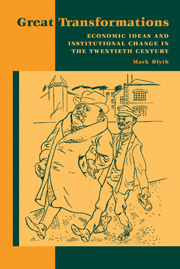Book contents
- Frontmatter
- Contents
- Preface
- Acknowledgments
- PART I THEORY
- PART II CASES
- 3 Building American Embedded Liberalism
- 4 Building Swedish Embedded Liberalism
- 5 Disembedding Liberalism: Ideas to Break a Bargain
- 6 Disembedding Liberalism in the United States
- 7 Disembedding Liberalism in Sweden
- PART III CONCLUSIONS
- Index
6 - Disembedding Liberalism in the United States
Published online by Cambridge University Press: 05 June 2012
- Frontmatter
- Contents
- Preface
- Acknowledgments
- PART I THEORY
- PART II CASES
- 3 Building American Embedded Liberalism
- 4 Building Swedish Embedded Liberalism
- 5 Disembedding Liberalism: Ideas to Break a Bargain
- 6 Disembedding Liberalism in the United States
- 7 Disembedding Liberalism in Sweden
- PART III CONCLUSIONS
- Index
Summary
Building Muscle: The Remobilization of American Business
The policies and practices of the late 1960s and early 1970s detailed in the previous chapter created a new sense of uncertainty among American business. Inflationary pressures, regulatory initiatives, hostile tax legislation, and general policy paralysis combined to convince business that it was under siege within the institutions of economic governance that business itself had designed. Caught between “an avalanche of Congressional, consumer and blue-collar criticism … executives became increasingly aware that they needed better negotiating techniques at the federal level.” To facilitate this, American business both reinvigorated existing business institutions and developed new ones to protect itself.
For example, the National Association of Manufacturers (NAM) moved its headquarters to Washington, D.C., in 1972 and immediately shifted away from its traditional stance of doctrinaire antireformism toward lobbying, legal research, and closer cooperation with the American Chamber of Commerce (ACC). The ACC went through a thorough revitalization during the 1970s, growing from around sixty thousand member firms in 1972 to two hundred fifty seven thousand by 1982. This quadrupling of members, combined with a sliding fee scale proportionate to income, gave the ACC a budget of $80 million per annum. The ACC also reorganized itself internally and began to operate in three principal areas.
- Type
- Chapter
- Information
- Great TransformationsEconomic Ideas and Institutional Change in the Twentieth Century, pp. 152 - 201Publisher: Cambridge University PressPrint publication year: 2002



